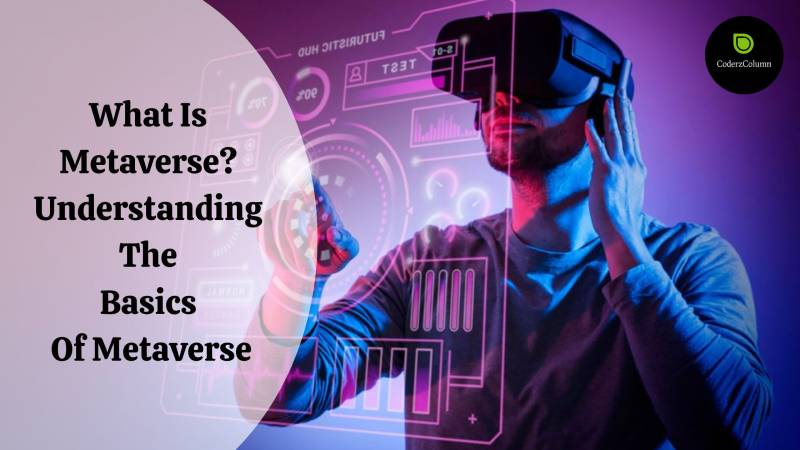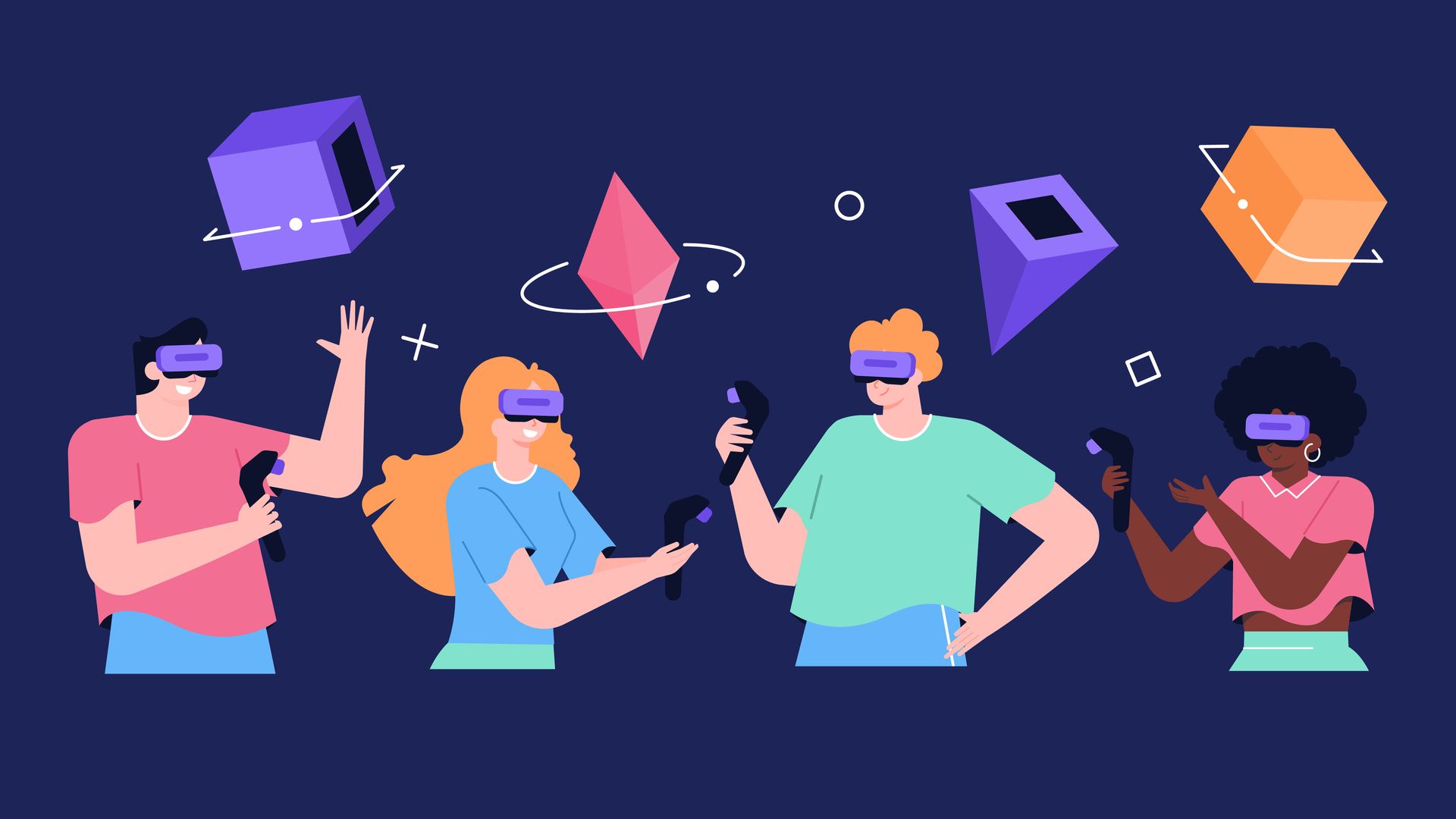
What Is Metaverse? Understanding The Basics Of Metaverse¶
A metaverse is a network of 3D virtual worlds oriented on social interaction. It is a simulated digital environment that employs augmented reality (AR), virtual reality (VR), and blockchain.
We've all been hearing and reading about the Metaverse lately. This word has acquired popularity all across the world. Everyone is curious about what it is and how it works. If you are seeking answers in the metaverse, this article may be helpful.
It includes almost everything, including games, meetings, and shopping. To enter Metaverse, first put on a headset and then connect to the virtual reality interface.
Table Of Content:¶
- 1. The Metaverse Explained
- What Do You Mean By Metaverse?
- What Features Define The Metaverse?
- There Are No Boundaries Or Limitations
- There Is No Single Authority
- It Is Perpetually On And Cannot Be Turned Off
- The Functional Economy And Its Comparison To The Real World
- It Offers a Multi-Sensory Immersion
- People are Capable of Forming True Social Bonds
- 2. Understanding The History Of Metaverse
- 3. Knowing The Basics
- 4. Metaverse's Rise
- 5. What Is The Negative Aspect Of Metaverse?
- 6. India's Contribution to the Metaverse
- 7. Metaverse’s Seven Layers
- A Dismaterialized Reality Experience
- Exploration and Discovery of a Huge Dynamic World
- A thriving economy for creators
- Blurring the Lines Between the Real and Virtual Worlds Through Spatial Computing
- A Distributed Experience Using Interoperable Components
- Human Interfaces That Enable Direct Interaction
- An infrastructure that enables the creation of a larger virtual network and interfaces
- Conclusion
1. Metaverse Explained ¶
To begin the Metaverse Guide, let's define what the Metaverse is. The definition of the metaverse is open-ended and can apply to many experiences. With a VR headset, you can completely immerse yourself in the metaverse. However, a more portable digital overlay allows the metaverse to blend into the physical world. Through Pokémon GO, this augmented reality-based strategy lately garnered a lot of popularity.
It's important to remember that the metaverse contains emergent characteristics. Collaboration between online and offline components is possible, as is the blending of the two. The opportunity for ongoing growth and development is made possible by this. In essence, the metaverse is an additional digital realm that coexists with our own. However, it's a cosmos that can meld with ours to provide experiences that are immersive, engaging, and incredibly realistic.
The metaverse is still a work in progress and may be seen as an incredible experiment that keeps surprising us with fresh discoveries. The notion can be interpreted radically differently by various businesses and developers. Future developments in the metaverse are completely unknown. But you can dive in right now and experience that development for yourself.

2. What Do You Mean By Metaverse? ¶
The phrase "metaverse" is not new; it has been used and explored extensively in films, comic books, video games, literature, and other media. It reflects multiple versions of the same notion, depending on the source: linking individuals from distant places, independent universes, or spheres of existence and allowing them to engage with one another.
When we apply it to the actual world and technology, we obtain the notion of the metaverse, which refers to a new version of the internet. This was envisioned as a new type of environment that enables more immersive social sharing.
It encompasses a wide range of goods and innovations, including NFTs and cryptocurrencies, 3D avatars, decentralized apps, virtual worlds and landscapes, the capacity to earn prizes, take part in airdrops, and carry out transactions via smart contracts, run enterprises in a virtual world, and more.
According to the Decrypt online magazine, the metaverse is an alternate reality that "represents a collection of open worlds and settings, united through interoperable materials and experience."
It is a virtual environment with working economies, avatars, digital products, and other features where technology is more than simply a tool.
This demonstrates the enormous potential for metaverse to alter the nature of interpersonal interactions. More than that, technology has the potential to alter how companies run, as well as how and what we spend our money. The metaverse may also represent the next phase in human society's technical and social development.
You will discover more about the features of the metaverse in this section of the handbook. The metaverse is always evolving. As a result, whenever users check-in, they can constantly anticipate discovering fresh features and surprises. However, a few aspects of the metaverse are shared by all of its implementations. It is possible that different implementations will interact with these rules in various ways. You can, however, generally rely on these focal areas inside every metaverse variant.
3. What Features Define The Metaverse? ¶
You will discover more about the features of the metaverse in this section of the handbook. The metaverse is always evolving. As a result, whenever users check-in, they can constantly anticipate discovering fresh features and surprises. However, a few aspects of the metaverse are shared by all of its implementations. It is possible that different implementations will interact with these rules in various ways. You can, however, generally rely on these focal areas inside every metaverse variant.

There Are Boundaries Or Limitations¶
The metaverse is crucial because it has no limitations or restrictions. You may come upon locations where you are unable to progress. However, this is merely due to the fact that nothing has yet been developed in those locations. The space is virtually infinite. It only has to be used correctly by metaverse-centered programmers.
There Is No Single Authority¶
The metaverse is not like a single house or structure owned by a single individual. It's more like a vast plot of land with a diverse population. People have deeds and proof of ownership in the physical world. People frequently exhibit it in the metaverse using blockchain-related systems.
It Is Perpetually On And Cannot Be Turned Off¶
There is no way to stop the earth. The metaverse cannot be turned off, either. It is a decentralized system with several autonomous pieces. It's true that some metaverse components might only be present on a single server, which might fall offline. However, there are several servers hosting the metaverse.
The Functional Economy And Its Comparison To The Real World¶
You may anticipate a working cryptocurrency-based economy in the metaverse. People will use it to purchase digital items or real-world-like real estate. Art-based digital assets are generally safeguarded as NFTs. Buying and selling are made possible by all of this.
It offers a Multi-Sensory Immersion¶
One or more senses are completely engaged by the metaverse. Typically, this is what you see when using VR glasses. Of course, auditory cues are received through headphones as well. However, the metaverse has the capacity to completely immerse humans through any of their senses. Allowing users to alter their virtual world is another aspect of this immersion.
People are Capable of Forming True Social Bonds¶
People can establish genuine social bonds in the metaverse. These encounters frequently include other people. However, social stimulation may also be obtained via encounters with AI. People that engage in social contact are constantly astonished and open to new experiences. The economics of the metaverse and more exploration follow from this.
Understanding The History Of Metaverse¶
Neal Stephenson developed the word Metaverse over 30 years ago in his science fiction novel Snow Crash, in which he imagined lifelike avatars meeting in realistic 3D buildings and other virtual reality scenarios.
In the past few years, Metaverse has evolved to mean a utopian convergence of digital experiences powered by Moore's Law - an aspiration to enable rich, real-time, globally-connected virtual- and augmented-reality environments that will allow billions of people to work, play, collaborate, and socialize in entirely new ways, according to IANS.
Knowing The Basics¶
For the uninitiated, the metaverse is essentially a hybrid of the physical and virtual worlds. The simplest way to comprehend the metaverse is to comprehend what it is not. It is not a new technology, program, or application. It is rather a method of merging already existing technology to create something termed a "digital environment."
Digital space is not a novel notion. It dates back to 1992 when Neal Stephenson described the metaverse in his science fiction novel Snow Crash as "a computer produced virtual world made conceivable by software and a global fiber optic network technology."
4. Metaverse's Rise ¶
Indeed, Mark Zuckerberg, the owner of Meta (previously known as Facebook), predicts that the fundamental characteristics of the metaverse will take five to ten years to become ubiquitous. However, the metaverse is rapidly expanding.
You can see that ultra-fast internet connections, virtual reality headgear, and permanent always-on online worlds are already operational, albeit they may not be available to everyone.

5. What Is The Negative Aspect Of Metaverse? ¶
According to an IANS article, Meta (previously Facebook) is aware that virtual reality might be a "toxic atmosphere,", particularly for women and minorities, and that turning off "mainstream customers from the medium totally" would be an "existential danger" to Facebook.
"Harassment in digital settings is not new, and we and others in the industry have been working to solve it for years. That work is underway and will very certainly never be completed. It is always changing, yet its significance stays constant. It's a massive undertaking, "IANS reported Meta CTO Andrew Bosworth as saying.
6. India's Contribution to the Metaverse ¶
According to the IANS report, Mark Zuckerberg stated that as the social network takes the first steps toward creating augmented reality (AR)-driven Metaverse experiences for billions, India and its massive pool of talent would play an important role.
Zuckerberg stated during the company's 'Fuel for India' event that he is really thrilled about the role that India will play in constructing the future of Metaverse, which would be the successor to the mobile internet.
"This is because India's talent pool – engineers, developers, and artists, as well as the entire robust startup environment – is playing a significant role in defining the future. India is on course to become the world's largest app developer base by 2024. It already has one of the largest development communities for 'Spark AR.' "During a chat, Zuckerberg informed Vishal Shah, VP of Metaverse.
7. The Metaverse's Seven Layers ¶
You will discover more about the seven realms of the metaverse in this section of the blog. The metaverse may be thought of as having levels that enclose its users. It's important for people to remember that these layers are not in any specific sequence. However, when individuals explore or improve these levels, they become increasingly interconnected with the metaverse. As they become more powerful or present in each layer, they become more completely residents of the metaverse. Jon Radoff, the creator of the blog Building the Metaverse, proposes the seven levels.
1. A Dismaterialized Reality Experience¶
People frequently imagine the metaverse as a three-dimensional realm. And it's true that most people engage with the metaverse in this manner. VR goggles, for example, mimic 3D surroundings. Users may grab and manipulate objects in 3D environments thanks to interface devices. However, the metaverse is not a three-dimensional space. It's also not a 2D space.
The metaverse, on the other hand, is a dematerialized world in which spatial dimensions are unimportant. Alexa, for example, resides within little things that link to huge quantities of data. And users in the metaverse can explore enormous swaths of virtual territory that eventually shrink to the size of a hard disc.
The metaverse effectively eliminates people's understanding of spatial dimensions. And this isn't limited to the metaverse. The internet of things (IoT) can bring the metaverse into the actual world, just as individuals can locate real-world aspects within the metaverse.
2. Exploration and Discovery of a Huge Dynamic World¶
Exploration of the metaverse is a crucial layer that is occasionally difficult to comprehend. Exploration involves more than merely perusing a virtual 3D scene. Of course, deeper immersion in the metaverse experiences includes this kind of investigation. The opportunity to be among the first to experience brand-new sights in the metaverse's constantly-expanding landscapes appeals to a lot of individuals.
However, as was already said, the metaverse is more than just 3D spaces. Inbound discoveries are also a part of exploration and discovery. For instance, users will frequently access content made by the community. Additionally, there are frequently businesses searching for individuals with particular and complementary hobbies.
The metaverse also allows for outbound discovery. For instance, what most people consider spam or ads would be termed outbound discovery. But there is a characteristic shared by all of these situations. They all focus on individuals discovering fresh experiences in the metaverse.
3. A thriving economy for creators¶
The metaverse is home to a robust economy. As was already said, cryptocurrency-based blockchain-based exchanges are frequently used in the metaverse. The economy of the metaverse, however, involves more than just exchanging money for products and services. The metaverse's economy is distinct from the real world in that it is a creator economy.
The early web and the metaverse both underwent two distinct phases of growth. The pioneer era is the first. To produce material in the digital sphere during this time period, one needed to be highly skilled. To produce material for the early internet or metaverse, for instance, one would need to be a skilled coder. The engineering age followed when new technologies made it simple for even inexperienced coders to create content.
4. Blurring the Lines Between the Real and Virtual Worlds Through Spatial Computing¶
The boundaries of spatial dimensions frequently disappear in the metaverse, as was already mentioned. The lines between the digital and analog worlds are more blurred as the metaverse grows. What is real and what is virtual? The idea that the digital world isn't real is simple to state. But what if your money, unique purchases, and even real estate are all done online? That makes it feel extremely genuine. Similarly, a VR space can have nothing to do with the substance of that place.
In the meanwhile, 3D places can be simulated in digital worlds. You may stroll along simulated paths and observe tangible results. You may travel virtually long distances, burn calories by moving your arms or legs, and simply unwind while gazing out into far-off horizons.
In some ways, you're not moving a huge distance in analog terms. You may be walking in place or along a little path. What counts is how you feel.
5. A Distributed Experience Using Interoperable Components¶
A single entity or component manages a completely digital system in centralized computing. This is the simplest method of designing or using networks. However, it does not provide end users with much independence or authority. Instead, the metaverse relies on decentralized development. This means that the metaverse is made up of several independently owned and developed components.
The precise nature of decentralization differs depending on the implementation. However, interoperability is a critical factor shared by all components of the metaverse. People develop elements based on norms, allowing them to communicate with one another. This implies that components may be removed and replaced. This is analogous to removing RAM from a computer and replacing it with RAM from a different manufacturer.
To interact with entities like the blockchain, the metaverse employs common standards. However, it also implies that users can create their own extensions or programs.
6. Human Interfaces That Enable Direct Interaction¶
People frequently underestimate how much they engage with technology. A smartphone, for example, is less of a phone and more of a supercomputer with a powerful network behind it. These gadgets also feature a variety of sensors and some basic AI to help with interaction. And practically everyone interacts with it without giving it much consideration during the day.
Smartphones aren't only growing smaller and more user-friendly. They're also being incorporated into metaverse interface devices. The Oculus Quest, for example, is effectively a hybrid of VR and cellphones. The integration method essentially develops a human interface into the metaverse. People are increasingly becoming cyborgs.
7. An Infrastructure That Enables The Creation Of A Larger Virtual Network And Interfaces¶
Finally, the metaverse is supported by a complicated infrastructure. People frequently regard this as a hazy system. However, most individuals are familiar with the metaverse's components. Everyone, for example, is familiar with wireless networks due to their regular usage of their phones. 5G networks will do more than simply increase call quality. It also provides faster data rates. This means that people's access to the data-rich metaverse will improve.
The enhanced power of mobile devices allows for a more user-friendly interface. However, it also implies that it is easier to build VR and other display devices in small form factors. The Oculus Quest demonstrates that manufacturers may design systems that integrate mobile components with VR technology.

The large-scale convergence of characteristics of various technologies aids in the advancement of the metaverse's infrastructure. As technology advances, more people will have access to the metaverse.
Conclusion¶
For more updates on Metaverse, stay tuned to CoderzColumn. We will share all the essential fundamentals and advanced concepts of Metaverse.
Reference Articles Of Metaverse And Related Concepts¶
 Dolly Solanki
Dolly Solanki
![]() Want to Share Your Views? Have Any Suggestions?
Want to Share Your Views? Have Any Suggestions?
If you want to
- provide some suggestions on topic
- share your views
- include some details in tutorial
- suggest some new topics on which we should create tutorials/blogs



 Want to Share Your Views? Have Any Suggestions?
Want to Share Your Views? Have Any Suggestions? metaverse, basics
metaverse, basics
